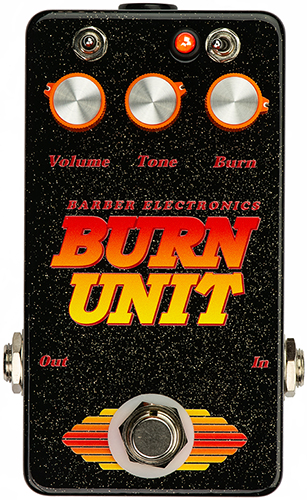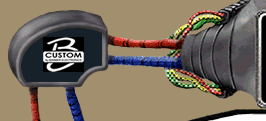Compact Burn Unit

The Compact Burn Unit is a very wide range overdrive which uses a simple control-set meant to quickly guide you between sounds. There are 2 three-way toggles, one for midrange and another for dynamics. The dynamics control sets the point where the distortion starts to compress and breaks up. You can dial in anything from barely there edge of breakup, to vintage tweed, 60s-70s rock, and a very serious mega dollar fusion amp sound. The midrange control gives you levels between neutral to mid-forward. Made in USA.
Check out the manual
All hand made in the US with bold and beautiful thru-hole components , a mix of NOS and current parts, and only $199.95
Stock changes, email before sending paypal.
Ordering is easy, just send an email to david@barberelectronics.com and we will update on stock and color available, then send you a paypal invoice. In stock items ship the next business day and travel USPS priority.
Paypal accepted, USPS priority shipping $8 in the US,
email for paypal invoice.
------------------------------------------------------------------------------------------------------------------------------------------------------
David’s take: The Burn Unit has been a 27-year project to design and manufacture an analog circuit that can closely replicate the sounds of amplifiers producing different levels and textures of distortion, while keeping a simple, easy to understand control-set. The one amp that set the journey off more than any other was a Dumble ODS, which was in my studio for an extended stay. When the amp was at low volume levels the overdrive was not terribly inspiring, or distinct from other master volume amps, but when the amp could be played at loud club levels, it was fantastic. Since I had been able to spend time inside the chassis, I could see that the power amp was somewhat like Fender amps I had worked on, although it had some tweaks in the phase inverter and power supply. I also had the chance to look inside and play two other Dumble ODS amps that belonged to another friend, they were a little older and had Fender transformers. So, the average guitar player using a nice tube amp, might have something reasonably close to the output stage of the little known, but rather expensive ($5,000 at the time) Dumble. The preamp on the Dumble had some neat features like a “jazz/rock switch, I preferred “rock of course”, it seemed a lot of other ODS users did too when I saw them play live. This setting was most like a Fender blackface, although again with some tweaks. To sum it up, a Dumble is still a tube amp with lots in common with classic tube amps, the main thing being the difference between the distortion, voicing and texture that can be created in the overdrive section of the preamp. A pedal, when thoughtfully designed, can go a long way to reproducing this sound.
By 1998 I had started making pedals, I was selling Tone Pump overdrives and had good reviews. I thought I should revisit the ideas I had for my Burn Unit project. I had come up with a basic set of controls that could get a lot of textures from lot of amps. I thought it was just as important to emulate distortion from Fender Tweeds amps (large and small), blackface, vintage Marshalls along with that somewhat unknown Dumble ODS sound that I really liked. I never thought I could market a pedal that only created a Dumble sound since only serious guitar nerds knew what it was. I also liked some advantages that op-amps had, I could make complex chords sound clearer, you could actually play 5 note chords with a lot of sustain, where with a magic tube amp cranked you were lucky to get a 4-note chord to work well, usually leaving out the 5th, but that dom7#9 is still pretty cool!
I also wanted the Burn Unit to have a voicing that was complimentary to a guitar’s tone knob. I loved how Larry Carlton “rolled the tone knob back to 3” on Kid Charlemagne and other tunes, and Eric Johnson got that thousand-pound violin tone from rolling the tone knob way back, but with pedals, the voicing of the tone knob could be redundant and end up sounding compressed or heavily muted. When guitar players roll the tone knob back on the bridge pickup, you get to build the harmonics against the guitar’s fundamentals, instead of building harmonics on top of harmonics, which gets splashy sounding. The “tone knob trick” goes a long way to getting that detailed but soft distortion (read: no ice pick). You just set the Burn Unit (or amp) for plenty of harmonics/sustain and top, then roll back the tone knob on the guitar to get a fat balanced tone, all the experienced players know this trick.
The Dynamics knob (now a 3-way toggle) allows you to set the point a secondary compression/distortion kicks in. The Burn Unit has two clipping sections, each can be adjusted, much of the thinking here was, tube amps clip in at least two places, the preamp and the power amp, and often one handles more of the harmonics/texture than the other. The Burn Unit can achieve this between the Burn setting, and dynamics setting. In keeping with tradition, the compact Burn Unit has an internal bass trim pot, it’s set to work with neutral amps at our shop, so you may never need to touch it, but, if you like internal controls, and want to give it a twist, you can dial in the bass to match your own amp.
Specifications, knobs and color subject to change.












